Final Four Press Earned Mason $677 Million in Free Publicity, Study Finds
 Used with permission of editorial cartoonist Gary Brookins. Originally published March 2006 in the Richmond Times-Dispatch before Mason's Final Four appearance.
Used with permission of editorial cartoonist Gary Brookins. Originally published March 2006 in the Richmond Times-Dispatch before Mason's Final Four appearance.
-------------------
Two aliens on a spaceship orbiting Earth are talking. One says, “We’ve been intercepting their telecommunications for a week….best we can tell, their leader is George Mason.”
This editorial cartoon, published in the Richmond Times-Dispatch the week after Mason’s dramatic win over the University of Connecticut in the Elite Eight, said it all. For a while, no one could talk about anything but George Mason.
Dale Van Wagner, the student body president at the time, distinctly recalls the large amount of press coverage.
“If you were a student, you couldn’t walk from your dorm to class without getting asked for an interview,” Van Wagner said. “The circle in front of the statue was just packed with news trucks.”
Van Wagner recalls one incident in which he picked up the phone in the Student Government Office to find he was live on the air on a sports talk radio show in Albuquerque, New Mexico. The hosts wanted to ask him a few questions about Mason’s run.
The Office of Media and Public Relations at Mason felt the impact of such media interest as well. Press Secretary Dan Walsch said the attention was overwhelming for the office and almost too much to handle. In the years since, several employees have been added, partly to accommodate the exposure gained by Mason’s new notoriety.
Associate Professor of Sports Management Robert Baker, who performed a study looking at the media gained from Mason’s run to the Final Four, estimates that Mason gained $677,474,659 of free publicity from the 2006 NCAA tournament run.
“People look at that and say, it’s just an outrageously large number,” Baker said. “But there was a large amount of exposure.”
Baker calculated his number by measuring the amount of broadcast time of games and coverage on television and column inches of articles in print media and multiplying those numbers by the advertising rates of the outlets. He did not include regional television networks outside of the Washington, D.C. area. He also did not count the number of AP articles reprinted in each of its 1700 outlets.
“The majority of those carried articles on Mason, probably more than one,” Baker said. “We had access to just shy of 900 articles.”
He also pointed out that Mason gained coverage in areas not available for advertising, such as guard Lamar Butler’s appearance on the cover of Sports Illustrated on March 27.
Mason’s win against UConn gained coverage on over 90 front pages of newspapers across the country.
“It’s hard to get on that many front pages in any way that’s positive,” Baker said.
“George Mason” was Google’s most-requested search the day of the Final Four game. Before the Final Four game, searches for “George Mason basketball” jumped by 294 percent. Baker mentioned that from his personal friends and cultural exchange connections, he knows that Mason’s Final Four story traveled internationally as well, to as far away as India and Asia.
“Whether it’s North America or somewhere else, it’s a point of reference people can still connect Mason to,” Baker said.
Baker contrasted Mason’s exposure with Gonzaga University’s estimated $37.8 million advertising value of its 1999 Elite Eight run. He said there were a number of reasons why Mason gained far more publicity during its run.
“The perception of many of the leaders of the university was that we had these great messages, and great conduits of the messages,” Baker said. “We had a personable coach [Head Basketball Coach Jim Larranaga] that knew the university and was fully integrated in the university.”
The accessibility of President Alan Merten, Dean of Admissions Andrew Flagel, and other high-level administrators also contributed to the coverage.
“Everyone was eager to tell Mason’s story,” Baker said. “Athletics is like the front porch of the university—everyone can see what’s going on there. It got people to open the door and look inside. This created a springboard, but you have to have substance to give the story a happy ending. “
Leaders throughout the university that Baker interviewed for his study agreed on one thing—though the Final Four helped Mason, the school was already headed for greatness.
“We were already on an upward trajectory,” Baker said. “Mason would have done these things anyway [without the Final Four run], but not as quickly.”
The interest in Mason’s story continues through today, as Baker receives calls from multiple media outlets every spring. When March Madness draws closer, sports commentators now ask, “Who is this year’s George Mason?”
“When something like this happens, if you don’t have much to offer, you can’t hide it and if you do have a lot to offer, you have that opportunity to get it seen,” Baker said. “We were the latter.”
---------------
The above piece was published in Mason Nation: Four Years Later, a magazine to released this April documenting and analyzing the university's development since the Patriots' historic run in 2006, aiming to shed light on what's connected to the Cinderella story--and additionally, what's not.
Led by senior history major and Student Media veteran Rachael Dickson, the magazine's other topics include changes in men's basketball to effects on other athletics, and from player profiles of the Final Four team to Ciao Hall's farewell and the rise of the Chesapeake residential neighborhood. Gunston and the pep band also receive shout-outs.
